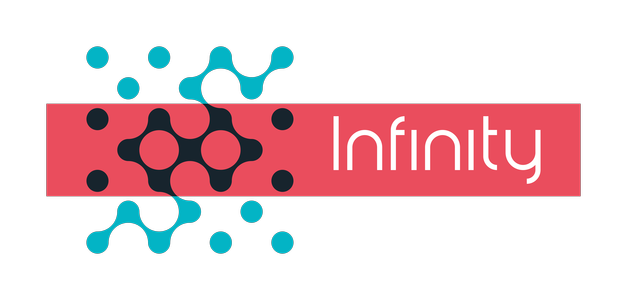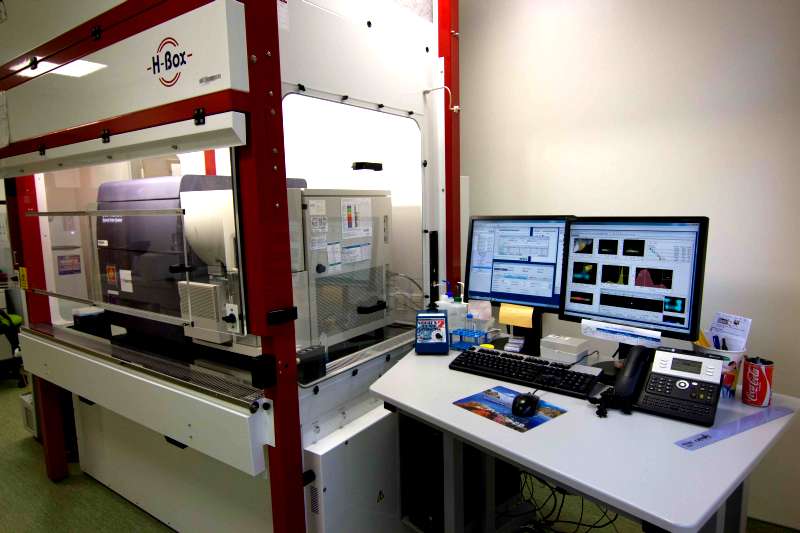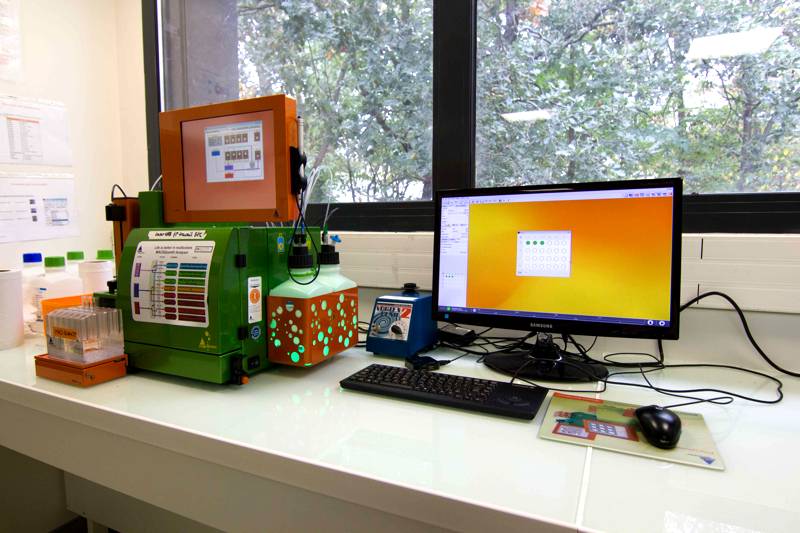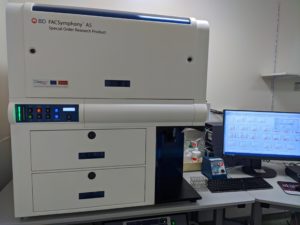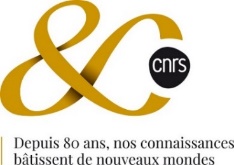Cytometry & Cell Sorting
The cytometry and cell sorting core facility of the Toulouse Institute for infectious and inflammatory diseases is connected to the Life Sciences Technology Platform “Toulouse Réseau Imagerie” (TRI) labeled IBiSA and member of the France-BioImaging national infrastructure. The facility is certified ISO 9001 (2015 version) and NF X50-900 (2016 version) and offers a wide array of resources and skills dedicated to cell sorting and analysis by flow and imaging cytometry. The facility is integrated in a biosafety level 2 laboratory, is equipped with 4 analyzers, 3 cell sorters and 1 image cytometer. The facility staff provides advice, assistance and training sessions for the use of flow cytometry, as well as courses at Toulouse University. We can also assist you in the optimization and development of research projects in the form of collaborations.
Our team
Managers: F.E.L’Faqihi-Olive & V.Duplan-Eche
Services provided
Analysis and cell sorting, upon request from research teams belonging to academic or private institutions.
Research & development
The engineers of the facility can assist you for the development of novel flow cytometry techniques to meet diverse scientific needs of research projects, in the form of either training and / or collaboration.
NEW : Optimized, ready to use panels on the 30-parameter BD FACSymphony cytometer
Training, advice, expertise
- Training for the use of analyzers
- Help to set up and/or to improve an experimental protocol
- Dedicated help for the design of optimized multicolor panels
- Providing scientists with expertise in flow cytometric techniques required for their research projects.
- Help with the analysis and interpretation of results
- Expertise for private laboratories
- Continuous education
- Training sessions ‘CNRS Entreprises’
- Cytometry data analysis with FlowJo
- Advanced Flow Cytometry and Standardisation
- Imaging Flow Cytometry
Applications
Flow cytometry analysis
- Flow cytometry analysis
- Multicolor surface staining
- Multicolor intracellular staining
- Cell cycle
- FRET
- Multiplex analysis
- Calcium flux
Imaging cytometry analysis
- Imaging cytometry analysis
- Spot counting
- Nuclear translocation
- Autophagy
- Cell cycle
- Internalization
Cell sorting
- High speed sorting
- 4-way sorting devices
- Single-cell sorting
Data analysis
Training and support for the use of software dedicated to flow cytometry analysis (FlowJo, OMIQ) and imaging cytometry (IDEAS).
Equipments
Sorting
- Cell sorter FACSARlA-ll: exc 488nm, 405nm and 630nm,
11 fluorescences Configuration (pdf) - Cell sorter FACSARlA-SORP: exc 488nm, 630nm, 350nm
and 405nm, 13fluorescences. Configuration (pdf) - Cell sorter FACSARlA-FUSION: exc 355nm, 405nm, 488nm, 561nm and 630nm, 18 fluorescences. Configuration (pdf)
- Speed : 30000 cells/seconde
- Sorting of 4 populations simultaneously
- Single cell sorting
Cytometers
- Symphony A5 (BD Biosciences) exc 355nm, 405nm, 488nm, 561nm et 637nm, 30 fluorescences. Configuration (pdf)
- Fortessa X20 (BD Biosciences) exc 355nm, 405nm, 488nm, 561nm et 640nm, 18 fluorescences. Configuration (pdf)
- LSR-Fortessa (BD Biosciences) exc 405 nm, 488 nm, 561nm & 633 nm, 16 fluorescences. Configuration (pdf)
- MACSQuant10 (Miltenyi Biotec) exc 405nm, 488nm et 633nm, 8 fluorescences. Configuration (pdf)
Imaging flow cytometry
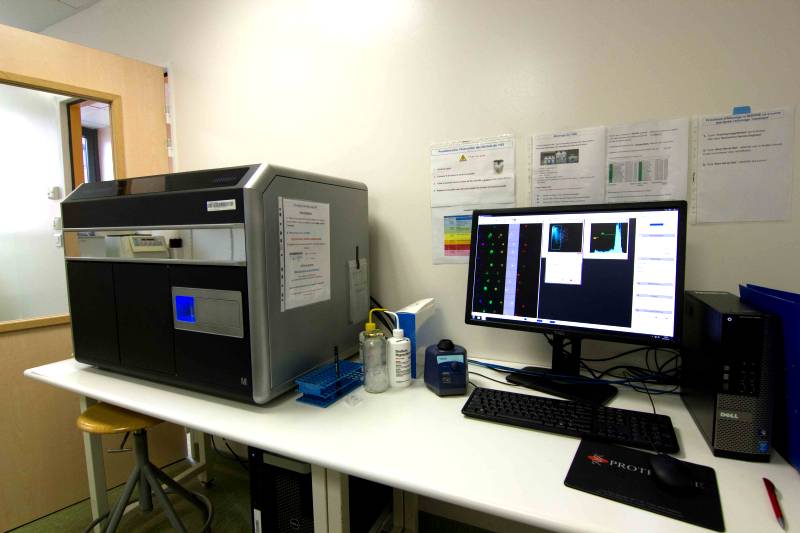 ImageStreamX MarkII
ImageStreamX MarkII
- exc 405nm, 488nm et 633nm, 6 channels
- combines flow cytometry and microscopy in a single instrument platform.
- Applications include the study of
cell-cell interactions, phagocytosis, apoptosis and autophagy, and many other
Contact, booking and self-service
Use of cytometers analyzers in self-service
An adequate training is provided by the facility staff for users wishing to work independently on all analyzers. Autonomy is subject to a quality process.
Operating procedure
The applicant must first fill out a sheet requesting the use of the core facility. Next, the staff engineers direct the users to the most appropriate device for their experiments. The user is informed about the rules of use of the facility. An appointment is then made for a training session, at the end of which the user is granted use of the device and can manage his own reservations.
For any assistance, the users must make an appointment with the staff of the core facility.
Use of cell sorters
The cell sorters are controlled by the staff of the facility. Users wishing to sort cells should contact the staff for an appointment.
Other information
Steering committee
Scientific Advisor : S. Laffont-Pradines
- F. Masson (Equipe N. Blanchard)
- S. Fruchon / Y. Degboe (Equipe J. Ausseuil / R.Poupot)
- A. Dejean / F. Bucciarelli (Equipe A. Saoudi / L. Liblau)
- N. Collercandy (Equipe J. Izopet / B. Lagane)
- H. Martin (Equipe D. Dunia / C. Malnou)
- C. Pérals (Equipe N. Fazilleau / S. Guerder)
- A. Loste (Equipe N. Gaudenzio)
- B. Salomon (Equipe J. Van-Meerwijk / O. Joffre)
- N. Rouquié (Equipe R. Lesourne / L. Dupré)
- M. Savignac (Equipe J.C. Guéry)
- J. Kamphuis (Equipe L. Reber)
- S. Garnier (Equipe M. Simon)
- M. Diaz Munoz (Equipe M. Diaz Munoz)
- H. El Costa (Equipe N. Jabrane-Ferrat)
- E. Espinosa (IRSD)
Publications
2024
A flow cytometry method for quantitative measurement and molecular investigation of the adhesion of bacteria to yeast cells Sci Rep. 2024 Sep 9;14(1):20935
LFA-1 nanoclusters integrate TCR stimulation strength to tune T-cell cytotoxic activity. Nat Commun. 2024 Jan 9;15(1):407. doi: 10.1038/s41467-024-44688-3
2022
A selective LIS1 requirement for mitotic spindle assembly discriminates distinct T-cell division mechanisms within the T-cell lineage. Elife. 2022 Dec 15;11:e80277. doi: 10.7554/eLife.80277.
Outer membrane vesicles produced by pathogenic strains of Escherichia coli block autophagic flux and exacerbate inflammasome activation. Autophagy. 2022 Dec;18(12):2913-2925. doi: 10.1080/15548627.2022.2054040. Epub 2022 Apr 7.
2021
Stochastic asymmetric repartition of lytic machinery in dividing CD8+ T cells generates heterogeneous killing behavior. Elife. 2021 Jan 11;10:e62691. doi: 10.7554/eLife.62691.
2019
Increased CXCR3+ T Cells Impairs Recruitment of T-Helper Type 17 Cells via Interferon γ and Interleukin 18 in the Small Intestine Mucosa During Treated HIV-1 Infection. J Infect Dis. 2019 Jul 31;220(5):830-840. doi: 10.1093/infdis/jiz123.
2017
IL-33 fine tunes mast cell degranulation and chemokine production at the single-cell level. J Allergy Clin Immunol. 2017 Aug;140(2):497-509.e10. doi: 10.1016/j.jaci.2016.09.049. Epub 2016 Nov 19.
2016
Cytotoxic, apoptotic, and sensitization properties of ent-kaurane-type diterpenoids from Croton tonkinensis Gagnep on human liver cancer HepG2 and Hep3b cell lines. Fundam Clin Pharmacol. 2016 Apr;30(2):137-46. doi: 10.1111/fcp.12176. Epub 2016 Jan 18.
